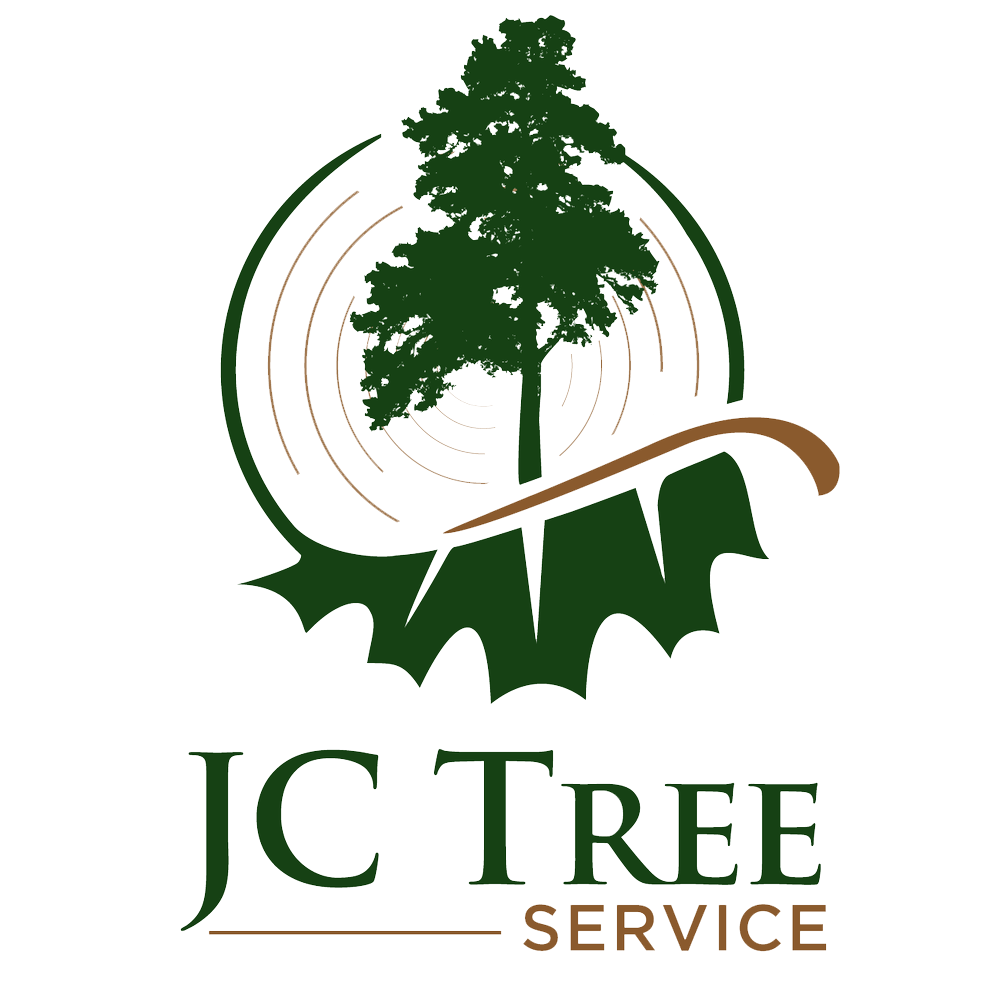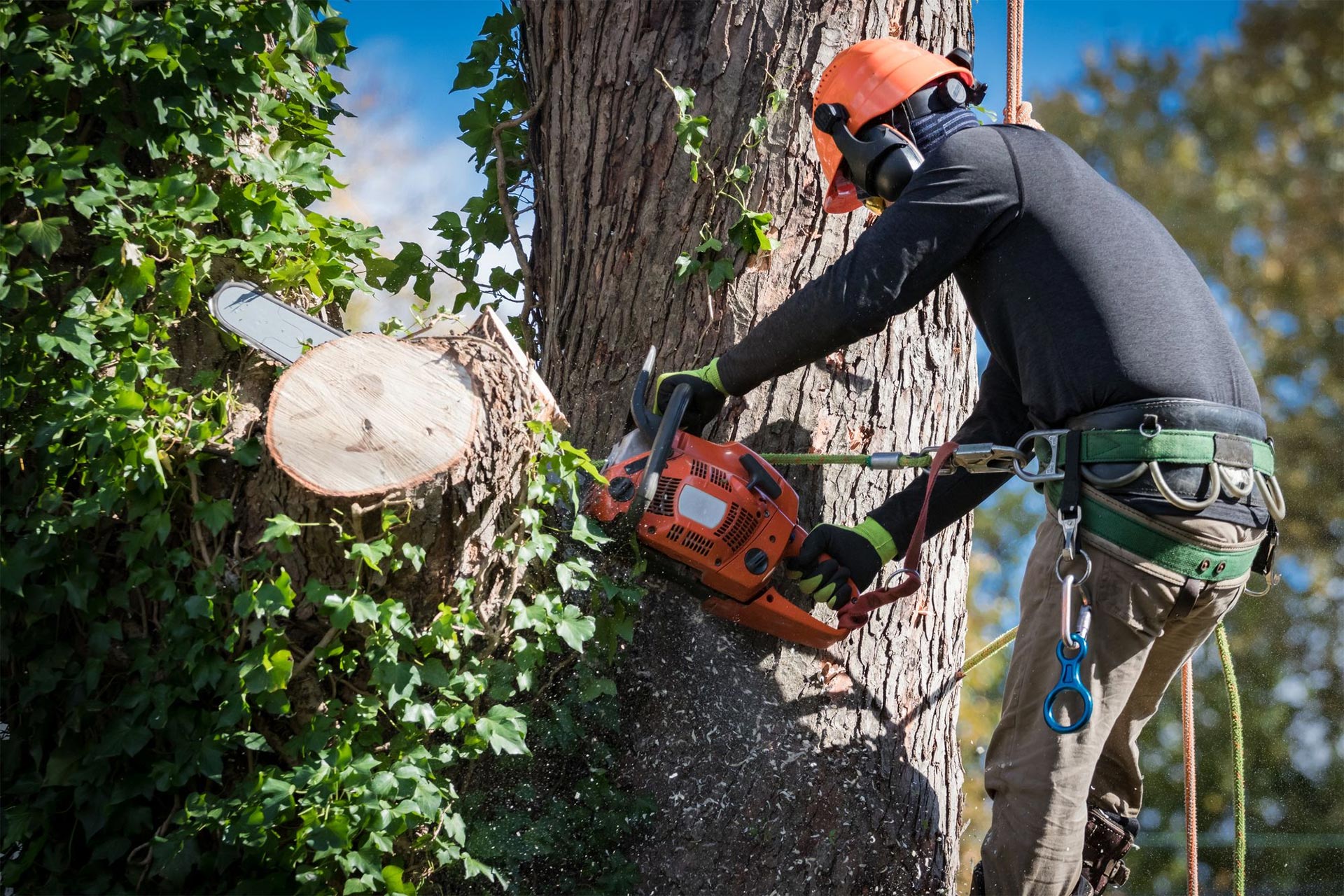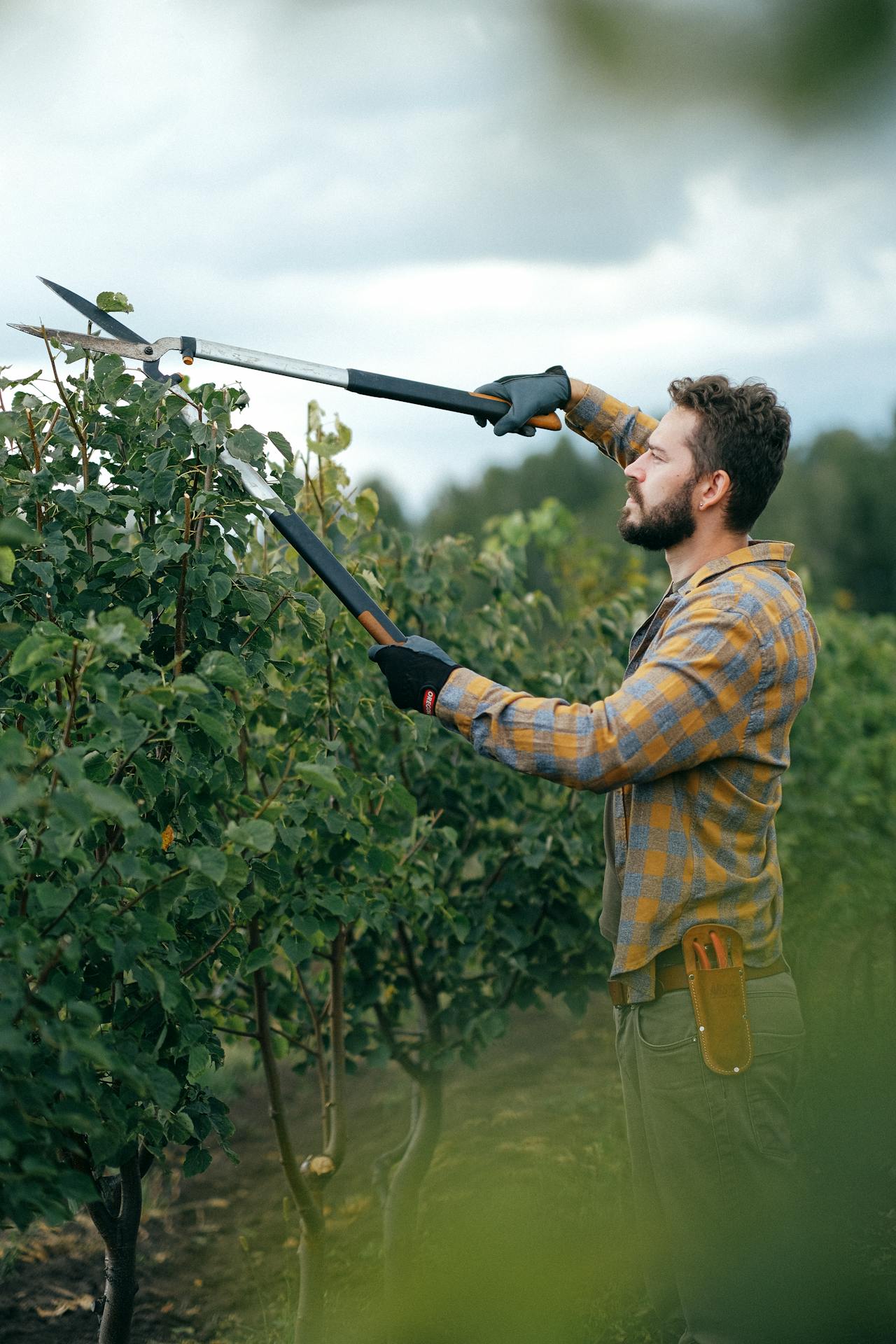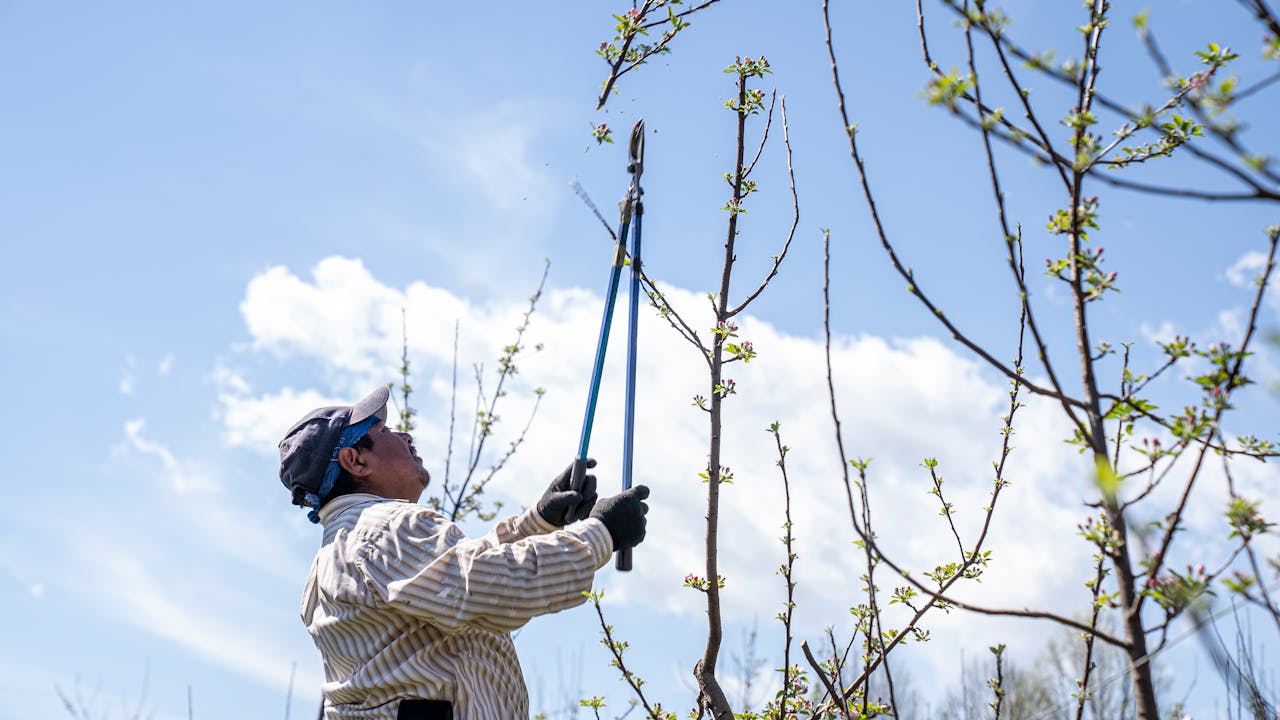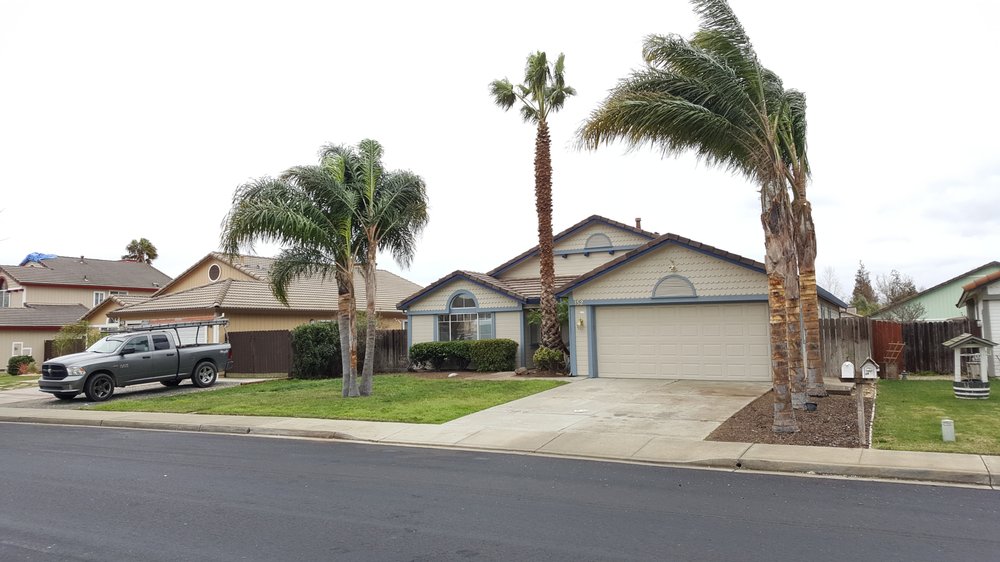Key Takeaways
- Tree topping is the indiscriminate cutting of the upper branches back to the stubs. This practice severely damages the tree’s health and disturbs its natural growth patterns. It has long been recognized as an unsustainable tree care practice.
- By removing a majority of the tree’s leaf area, topping robs trees of their ability to photosynthesize, inhibiting growth for years to come.
- Such topped trees will be more prone to pests and diseases. They become structurally unsound, leading to weak regrowth and increased vulnerability to falling branches.
- Exposed bark from topping leaves trees vulnerable to sunscald, which causes long-term damage, further weakening the tree’s structural integrity.
- Practice appropriate pruning methods such as crown reduction and selective thinning. These tactics are better for the tree’s health and keep the tree looking naturally beautiful.
- To get the best care for your trees, always consult certified arborists. With more sustainable methods, you’ll keep your trees healthier, improve safety, and increase the lifespan of your trees.
Tree topping means cutting the branches back to stubs or lateral branches. Topping trees is one of the practices that does more harm than good. It is an intentional and bad practice to remove large sections of the tree’s canopy—which is like removing a large part of the skeleton of a tree.
Topping creates a sudden change in growth conditions, often resulting in weak, fast regrowth that is much more prone to breakage. Wounds from improper cuts can further stress the tree, decreasing its lifespan and hardiness to disease and infestation.
Although this method is still sometimes used in an attempt to control height, it usually causes more permanent harm than it does in addressing the issue. It’s important to know the risks and negative effects of tree topping.
It’s what allows us to keep our trees healthy and provide quality, sustainable tree care.
What Is Tree Topping?
Definition Of Tree Topping
Tree topping is the practice of severely cutting back the upper branches of a tree to short stubs. These are typically drastic cuts, removing up to 50 percent or more of the tree’s crown. Although this may appear to be an easy method to keep a tree smaller, it stops the tree from growing naturally.
Trees rely on their crowns to absorb sunlight for photosynthesis. Take away the crown, and you compromise their capacity to create the energy necessary to thrive. In the long run, this practice creates a tree more susceptible to pests, diseases, and structural failure.
Topping damages trees in several ways, too, both physically and aesthetically. When a tree is topped, the tree responds by sending out weak, fast-growing shoots directly below the cuts. These new shoots are weakly attached and more prone to snapping off in high winds and storms.
Rather than solving problems, topping introduces new hazards that ultimately compromise the tree’s health and safety. Responsible tree care seeks to avoid such extreme measures, pursuing instead long-term solutions that promote the best interests of the tree.
Common Reasons For Topping Trees
Homeowners often consider topping to address concerns like overgrown branches near power lines, safety hazards, or simply to reduce a tree’s size. Some might think it’s for aesthetics—to make a tree look nicer by achieving a uniform shape.
These goals can often be met without doing serious damage to the tree. Proper pruning techniques—such as crown reduction or thinning—provide safer options. Topping is often selected by the unknowing as a short-term solution.
This approach usually just creates more issues than it fixes.
Misconceptions About Tree Topping
Topping is wrongly believed to promote healthy regrowth. In truth, it stresses the tree, making it use energy to mend the destruction. Perhaps the most widespread myth is that it’s a cheaper alternative for ongoing maintenance.
Their upfront costs seem less daunting on the surface. The future costs related to addressing tree death, danger, or removal can add up quickly. Topped trees still need to be watched over and maintained.
However, this is inefficient and unsustainable.
How Tree Topping Harms Trees
Nutrient Deprivation In Trees
Topping is the practice of removing a large portion of a tree’s canopy, often as much as 50% or more of its leaf area. Leaves are important for photosynthesis. Without them, the tree cannot produce the food and energy it needs to live.
Without sufficient leaf surface area, the tree cannot effectively absorb sunlight, which is necessary to convert nutrients into food. In the long term, decreased photosynthesis stresses the tree, resulting in compromised health and growth.
A topped oak tree might sprout shrubby growth and a shabby crown in the coming years. This alteration indicates that it is in a fight to rebound.
Increased Risk Of Pests And Diseases
When you top a tree, you remove large limbs, leading to ugliness and large cuts that open the tree to decay. This can open the door for pests and pathogens to invade.
These wounds rarely heal successfully, and they provide entry points for fungi, bacteria, and insects that can kill a tree. Additionally, the stress caused by topping weakens the tree’s natural defense mechanisms, making it more susceptible to attack.
Beetles are drawn to trees that are under stress. This attraction exacerbates the issue, and it can transmit disease to the trees around it.
Weak And Unstable Branch Growth
Topped trees respond by trying to regrow as fast as possible with many shoots. Yet this new growth is weakly attached and prone to breaking.
These branches usually grow in water sprout clusters, making the tree prone to structural weaknesses. Later, in wind or storms, these wounds will develop weak attachments, and the branches will easily snap, becoming safety hazards themselves.
A once-vibrant, fully topped maple tree, for instance, could end up growing fragile limbs that snap off with little to no provocation.
Vulnerability To Sunscald Damage
The abrupt loss of protected canopy cover exposes previously shaded bark to the harsh effects of direct sunlight. This can lead to a condition known as sunscald —damage that appears as cracks or peeling bark.
With each passing season, these injuries compromise the tree’s structural integrity and overall health. Bark injuries are a major threat, especially to species such as birch and ash.
These trees need those outer protective layers to help regulate moisture and temperature.
Reduced Lifespan Of Trees
Research indicates that more than half of topped trees will need to be removed within five years after topping due to irreparable harm incurred. These compounded effects of nutrient deprivation, disease, and weakened structure have accelerated their decline.
It is important to note that topping severely shortens a tree’s lifespan. It diminishes its ecological value, harming shade, air quality, and wildlife habitat.
Risks Associated With Topping Trees
Safety Hazards From Weak Branches
Topping trees usually leads to poorly attached branches sprouting from where cuts were made. These branches do not have the structural support needed and, therefore, are likely to break. In residential areas, this can result in tree limbs falling, creating a severe threat to human life, dwellings, and cars underneath.
With storms and high winds, large lateral branches are more likely to break off. This creates a significant risk of personal injury and property damage. For instance, a heavy topping branch that snaps in a storm may land on—and crush—someone’s roof or parked car.
Routine inspections of topped trees are critical for identifying and addressing poorly anchored branches. Keeping this process takes ongoing and consistent commitment and can be costly in the long run.
Long-Term Maintenance Challenges
Topped trees require significantly more care than properly pruned trees. The extreme cuts involved in topping force the tree to quickly produce new growth, usually resulting in a dense cluster of shoots.
These new shoots are weak and need to be pruned often to control. Over time, costs add up, and increased professional care becomes essential to your continued safety and well-being.
The resulting rapid growth then tends to overshadow nearby plants or structures, resulting in even more landscaping headaches. Topped trees cost several times more in time and money than trees that are properly pruned. Their maintenance demands can be truly daunting.
Negative Impact On Tree Appearance
Topping creates a serious aesthetic blunder by removing foliage that gives a tree its natural beauty and appeal. This very unnatural look can disrupt the beauty of your yard or community, hurting curb appeal.
So, a formerly majestic oak tree might be reduced to a hacked-down and ugly stump. The right pruning will bring out your tree’s natural beauty and help it become a beautiful focal point in your landscape.
On the other hand, topping takes away from that beauty.
Environmental Consequences Of Topping
Topping trees is bad math. Removing huge chunks out of a tree’s canopy immediately compromises the tree’s ability to deliver vital environmental benefits.
A smaller, weakened canopy sequesters less carbon and provides less shade, thus worsening urban heat island cooling effects. Additionally, topping trees can wipe out the homes of birds, squirrels, and other woodland creatures.
These species rely upon the tree’s branches for their habitat and food source. A healthy, untopped tree filters our air, mitigates climate change, and provides habitat for wildlife, so taking care of trees is essential for taking care of our planet.

Better Alternatives To Tree Topping
Choose The Right Tree For The Location
Choosing the proper tree species for your yard can help avoid problems down the road that lead to practices like topping. Other trees are simply inappropriate for our urban environment, growing too tall and thus competing with power lines or buildings. By selecting species that naturally conform to the available space, you eliminate the need for severe measures.
For example, planting a dwarf variety of maple in a small backyard will make sure that the tree stays healthy without becoming overbearing to its environment. When designing, take into account the expected mature height and spread of the tree. In this case, a tree that is allowed to grow 50 feet tall will not be suitable for planting underneath a future 20-foot utility line.
By choosing the right tree for the right place, we’re ensuring the health of the tree and the surrounding environment.
Implement Proper Pruning Techniques
Healthy growth begins with better pruning. Techniques such as crown thinning and selective branch removal allow specialists to keep a tree’s shape without compromising its structure. Crown thinning, for instance, cuts out branches located toward the center of the tree’s canopy, increasing sunlight exposure and air circulation.
This keeps trees healthier and more resilient, making them less likely to break. Timing makes a difference—pruning in late winter or early spring limits stress on the tree. When tree care professionals use clean, sharp tools, they make clean cuts that heal quickly and reduce the likelihood of disease.
Promote Sustainable Tree Care Practices
Proper, sustainable care is what ensures trees stay healthy and strong. Routine inspections allow for the early detection of issues such as pest infestations or structural defects in branches. Proactive strategies such as mulching or watering during dry spells are key for ensuring long-term health.
Communities gain so much from awareness campaigns, educating neighbors on why these sustainable practices are important,t and rejuvenating pride in the community.
Seek Professional Tree Care Services
Certified arborists provide the best care by bringing specialized knowledge to tree care. They determine what trees need and use techniques such as crown reduction safely. Consulting with professionals will help ensure that any cuts made are clear and strategic and preserve the tree’s natural beauty and health.
Restoring Health To Topped Trees
Steps To Encourage Healthy Regrowth
Topped trees are frequently predisposed to structural failure and should be made safe as soon as possible. The first step should be to evaluate the tree’s overall health and stability. Monitor for broken branches, exposed wounds, or weak points that may develop and get worse with time.
Understanding the tree’s health allows you to determine your next course of action. Correct watering and fertilization play a huge role in healing those cuts. Apply a slow-release fertilizer formulated for trees and water thoroughly, particularly during extended dry periods.
This makes sure nutrients can reach the roots. In this case, watering a tree once a week or more during hot summer months will help relieve additional stress. Inspect often for pests and disease, as topped trees are more susceptible.
Keep an eye out for symptoms such as yellow leaves or pinholes in the bark. Treating a tree early will be an easier process and may leave the tree with a better chance of recovery.
Address Structural Weaknesses In Trees
Topped trees will commonly create very unstable branches. Cabling and bracing offer additional support, helping to protect against falling limbs. This is particularly beneficial for mature trees or trees located in yards and along sidewalks.
Qualified professionals can use these systems to re-establish stability in the tree while improving safety. Now, ongoing monitoring is crucial. Eventually, they can outgrow themselves, causing new growth to become too heavy for branches that have been weakened by the practice.
Prune selectively to encourage new growth in desired directions and to retain specific shapes. Removing overcrowded shoots, for example, can avoid more serious injury and stimulate more vigorous growth.
Monitor And Prevent Pests And Diseases
To avoid potential pest and disease issues down the line, check your trees periodically. Keep an eye out for excess sap, drooping foliage, or mushrooms. Strengthening tree health with proper nutrition and watering not only helps trees flourish but also gives pests less opportunity to thrive.
Working with an arborist to create a pest management plan will protect the future.
Conclusion
Topping trees does more harm than good. It weakens trees, shortens their lifespan, and makes them more susceptible to pests and disease. The dangers don’t end with increased vulnerability to disease and decay. Topped trees eventually become safety hazards as the weak, undesirable regrowth leads to unstable branches. Rather than tree topping, using the right pruning methods or hiring a certified arborist will better safeguard your trees and landscape investment.
Healthy trees can be invaluable assets to your home or business, providing shade, beauty, and environmental benefits. Treating them properly is the best way to make sure that they grow healthy and strong for generations to come. If your trees have been topped, it’s not too late. Given the proper attention and time, they will bounce back. Don’t let the damage of improper tree care go unrecognized. They’ll pay you back in a million ways.
Enhance Your Landscape With JC Tree Service’s Expert Tree Maintenance
Proper tree maintenance is essential for keeping your property safe, beautiful, and well cared for. At JC Tree Service, we specialize in comprehensive tree maintenance services for homes and businesses in Brentwood, Antioch, and surrounding areas. Whether you need seasonal pruning, risk assessment, or help managing overgrown branches, our skilled team is here to ensure your trees stay healthy and safe year-round.
Our tree maintenance services are designed to prevent potential hazards, protect your property, and enhance curb appeal. With regular maintenance, we help you avoid risks from weak or damaged branches, manage tree growth, and support long-term health for a vibrant landscape. JC Tree Service focuses on eco-friendly practices, delivering solutions tailored to your needs while keeping your landscape organized and manageable.
Don’t let neglected trees jeopardize your property’s safety and beauty. Contact JC Tree Service today for a free, no-obligation quote on our professional tree maintenance services. Discover how expert care can transform your outdoor space!
Disclaimer
The materials available on this website are for informational and entertainment purposes only and not to provide legal or professional advice. You should contact your attorney or home improvement specialist to obtain advice concerning any particular issue or problem. You should not act or refrain from acting based on any content included in this site without seeking legal or other professional advice. The information presented on this website may not reflect the most current home improvement developments. No action should be taken in reliance on the information on this website. We disclaim all liability concerning actions taken or not taken based on any or all of the contents of this site to the fullest extent permitted by law.
